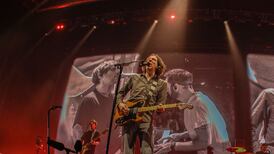Maybe it was JK Rowling's stratospheric Rich List ranking, or Marian Keyes selling 20 million copies. Whatever it was, something made me wish I could write like that.
So I made up my mind. This was my time. No more daydreaming. While everyone else was watching soaps, I’d be busily punching my keyboard. Sentence by sentence. Writing and rewriting. No interruptions.
Having worked as a features writer, I could easily pinpoint highlights in my job: the opportunities to interview authors. I was all the more awestruck because I had talked to them: Jodi Picoult, John Connolly, Anthony Horowitz.
But to dare dream that I too could be published? Especially given the decline of traditional book sales. The closure of some of our huge high street book shops. The understandable reluctance of big publishing houses to bet on unknown writers.
I had some success with short stories. People would sometimes ask if I’d thought about writing a book? I would say nothing. No point in owning up to the abandoned novels at the back of my wardrobe. The difference was that this time I kept writing until I finished it.
All writers tell you to write about what you know. So I set my story in Dublin newspapers. I wrote about two rival columnists, who engage in a war of words and wit through their anonymous columns. They meet and fall in love, each without realising that they’ve fallen for the enemy. It was fun to write.
It was also proving the easier part. I still had to get published. The first year involved endless drafts, constant self-doubt and sheer bloody-mindedness. And then I overcame my first hurdle. I found an agent. Suddenly everything felt more real and infinitely more possible.
Said agent’s first job was to point out that I was trying to break into one of the most competitive areas in publishing: commercial women’s fiction. As a complete unknown. Very. Difficult. Indeed. Fine, I said. And kept going.
Then the reality checks: the stream of “thanks but no thanks” from publishers. Many tempered with compliments for the book, but still, no thanks. Print publishers have good reason to be careful. Print costs money. Publicity costs money. Even with a fantastic cover design, brilliant blurb and well-managed publicity, print publishers can be left with thousands of unsold copies. Of a single book.
And traditional book sales have been falling. Even the huge, household names are suffering. In February 2011, both Dublin branches and nine British branches of Waterstones closed.
In contrast, e-book sales have been growing. More than one way to the top of Everest, it seemed. In 2011, Tesco began to carry Kindle e-readers, and in 2013 Easons joined forces with Kobo to carry its devices in all its stores. At the launch, Easons MD Conor Whelan pointed out that “one in five books sold on Easons.com are e-books”.
In the same year, Amazon founder Jeff Bezos stated that "eBooks is a multi-billion dollar category for us...up approximately 70 per cent last year. In contrast, our physical books experienced the lowest December growth rate in our 17 years as a bookseller..."
While I have an e-reader, my loyalties continue to be divided between print and digital books. So when my agent told me last June that my debut novel had been accepted by Tirgearr Publishing, an independently owned, Irish, digital-first company, and would be released as an e-book, I had mixed feelings.
Not because I wasn’t excited. Or grateful. Or relieved that after all the hard work, it would see the light of day. (The back of my wardrobe was looking a little full). It was because I didn’t know what to expect. Or what people’s reactions would be.
I shouldn’t have worried. Although a few people’s eyes glazed over when they heard “e-published”, the overwhelming response has been incredibly positive. While numbers for e-reader owners in Ireland aren’t known, the 2011 Harris Poll revealed that one in six Americans were using e-readers.
By mid-2012, estimates put e-reader ownership worldwide, at more than 807 million people. Worldwide today, e-book sales account for 36 per cent of the market. Put simply, for every 100 books bought, 36 are e-books.
Is this the end for the print book? Obviously not. E-readers are relatively new. And this is an adjustment period. Print publishers can’t afford to ignore the digital revolution. But it’s not unreasonable to think that printed and digital books will happily co-exist.
Tirgearr Publishing CEO Kemberlee Shortland says the company has published 116 titles since its official launch in February 2012. “By the end of this year we will have published 20 more.”
I will be one of those published authors. For that, and for the advent of digital publishing, I am grateful. Without it, my debut novel might be gathering dust.
Going Against Type by Sharon Black is published by Tigearr Publishing 2014 – tirgearrpublishing.com – and from Amazon, Kobo and usual e-reader outlets.













